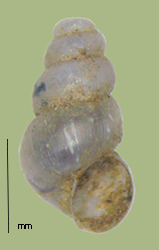> Habitat & Distribution
Fontigens
cryptica populations
seem to be obligately restricted to interstitial spaces in the
hyporheic zones of rivers in the interior karstlands. The
species
was initially described by Hubricht (1963) from underneath stones at
the mouth of a spring on a bluff overlooking The Ohio River in
southern Indiana. It has not been seen there since, although
J.
J. Lewis (pers. comm.) has recovered additional specimens from two
other sites in Indiana - both subterranean. In 2019 F. cryptica
was rediscovered by Ms. Lori Schroeder and colleagues at a springhead
in
the Bernheim Research Forest of central Kentucky. See my
essays
of 17July17, 6Aug17, 6Sept17 and 3July19 from the links below
to read the exciting tale as it has unfolded.
A broad-brush review of the zoogeography of North American
cavesnails has
been offered by Hershler & Holsinger (1990). FWGNA
incidence unranked.
> Ecology & Life History
The habitat of F. cryptica seems to suggest a diet that does not ordinarily include algae, but rather very fine organic matter or bacteria. Subterranean karst waters are, of course, very rich in calcium and many other minerals, as well as constant in their temperature.
Weck (2022) reported approximately one year to maturity (3 mm) in laboratory populations of the cave-dwelling Fontigens antroecetes, constant low levels of reproduction (25 - 80 eggs/pair/yr), and a lengthy hatch time of 70 - 80 days.
> Taxonomy & Systematics
Hubricht (1963) described the animal as "translucent whitish, blind" but did not offer any observations on the penial morphology. Hershler et al. (1990) were unable to re-locate any living specimens, and hence listed F. cryptica as a "species of questionable status." Liu and colleagues (2021) obtained a CO1 sequence from the single individual F. cryptica discovered in Kentucky in 2019, confirming its specific status. For a review of those results, see my essay of 9Aug22 from the link below.
Taylor (1966) suggested that Fontigens comprises a distinct hydrobiid subfamily, the Fontigentinae, which Hershler et al. (1990) synonymized under the Emmericiinae of Brusina (1870). Wilke et al. (2013) did not confirm a close association between Fontigens (represented by a single sample) and the European genus Emmericia, however, tentatively returning the Fontigentinae to subfamilial status. Despite this evidence, self-appointed experts insisted on placing Fontigens in the Emmericiidae for several years (Bouchet et al. 2017), until Gladstone & Whelan (2022) split the genus to its own separate family, the Fontigentidae.
> Maps and Supplementary Resources
> Essays
- Earlier versions of this website, online until August of 2016, adopted the large, broadly-inclusive concept of the Hydrobiidae (sl) following Kabat & Hershler (1993). More recently the FWGNA project has shifted to the Wilke et al. (2013) classification system, distinguishing a much smaller Hydrobiidae (ss) and elevating many hydrobioid taxa previously ranked as subfamilies to the full family level. For more details, see The Classification of the Hydrobioids.
- In 2017 I published a three-part adventure tale about the hunt for F. cryptica in the Bernheim Research Forest. Several additional photos of the little snail are available in my essay of 17July17, Lori Schroeder's Tiny Snails. I shared everything I know about their biology in my 6Aug17 essay, The Most Cryptic Freshwater Gastropod in the World, and described a field trip to Bernheim Not Finding Fontigens cryptica on 6Sept17.
- On 3July19 I reported the exciting news about Finding Fontigens cryptica. That essay featured photos of the living snail and its habitat. It concluded with a series of teasers about potential environmental threats.
- See my essay of 9Aug22, Startled by Fontigens, sort-of, I suppose for a review of the paper by Liu et al. (2021) confirming the specific status of F. cryptica.
> References
Bouchet, P., J. Rocroi, B.
Hausdorf, A. Kaim, Y. Kano, A. Nutzel, P. Parkhaev, M. Schrodl, and E.
Strong (2017) Revised classification, nomenclator and
typification of gastropod and monoplacophoran families. Malacologia,
61: 1 526.
Gladstone, N.S., E.
Pieper, S. Keenan, A. Paterson, M. Slay, K. Dooley, A. Engel, and M.
Niemiller (2021)
Discovery of the Blue Ridge springsnail, Fontigens orolibas
Hubricht 1957 (Gastropoda: Emmericiidae) in East Tennessee and its
conservation implications. Freshwater Mollusk Biology and
Conservation 24: 34 - 42.
Gladstone, N. S. and N.
Whelan (2022) Pushing barcodes to their limits:
phylogenetic placeament of Fontigens
Pilsbry, 1933 (Caenogasatropoda: Littorinimorpha: Truncatelloidea) and
elevation of Fontigentidae Taylor, 1966. Journal of Molluscan
Studies 88: eyab038.
Hershler, R. H. &
J. R. Holsinger (1990) Zoogeography of North
American hydrobiid cavesnails. Stygologia 5: 5-16.
Hershler, R., J.R.
Holsinger & L. Hubricht (1990) A revision of the
North American freshwater snail genus Fontigens
(Prosobranchia: Hydrobiidae). Smithsonian Contributions to Zoology
509:1-49,
Hubricht, L. (1963)
New species of Hydrobiidae. Nautilus 76: 138 -
140.
Kabat, A.R., and R.
Hershler (1993)
The prosobranch snail family Hydrobiidae (Gastropoda: Rissooidea):
review of classification and supraspecific taxa. Smithsonian
Contributions to Zoology 547:1-94.
Liu, H-P., L. Schroeder, A.
Berry, and R. T. Dillon, Jr. (2021) High levels
of mitochondrial DNA sequence divergence among isolated populations of Fontigens
(Truncatelloidea: Emmericiidae) in eastern USA. Journal of
Molluscan Studies 87: eyab026. [pdf]
Taylor, D.W. (1966) Summary
of North American Blancan nonmarine molluscs. Malacologia
4: 1 - 172.
Weck, R.G. (2022)
Life history observations of the Illinois state
endangered Enigmatic Cavesnail, Fontigens
antroecetes (Hubricht, 1940) made under simulated cave
conditions. Subterranean Biology 43: 185 - 198.
Wilke T., Haase M.,
Hershler R., Liu H-P., Misof
B., Ponder W. (2013)
Pushing short DNA
fragments to the limit: Phylogenetic relationships of hydrobioid
gastropods
(Caenogastropoda: Rissooidea). Molecular
Phylogenetics and Evolution 66: 715 736.








